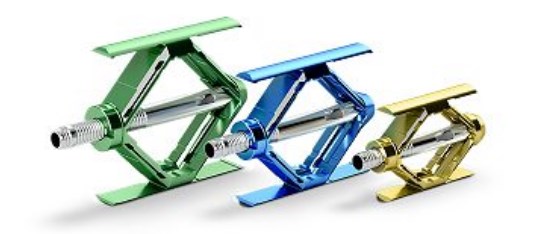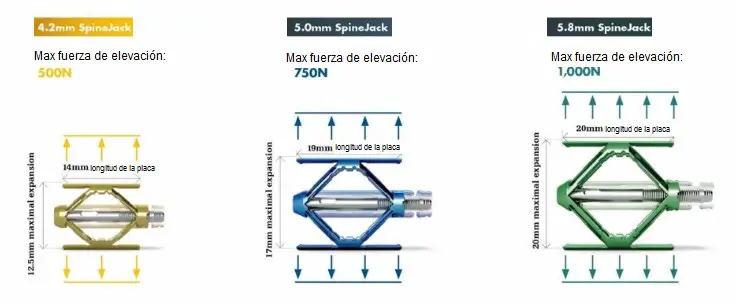
In vertebral compression fracturesón, the traditional treatment is the kyphoplasty, but the potential of this téconical to restore vertebral height isá limited by the péloss of height that occurs when the balloon is deflated and removedón. La témodern technique is the use of the SpineJack.
It is an instrument that alsoén is inserted percutáneatly but is then left within the vertebral body afterés de su expansión to reduce fracture, avoiding theí at péloss of correctionón before the injectionón of cement.
The results obtained in the úlast 10 añThey demonstrate that SpineJack provides both immediate and long-term benefits in tépain relief terms, the recoveryóno functional, and maintenance of the restorationón of vertebral height.
Index
EvolutionóNo of Vertebral Compression Fracture Proceduresón
The vertebroplasty (VP), spaghettién known as vertebral augmentation (OF) and bal kyphoplastyón, has been used for más de 30 añfor the treatment of compression fracturesón vertebral osteoporótica.
The VA without formationón of cavities with balóIt doesn't work because it allows the cement to flow along the lines.ífracture lines, but usually cannot restore vertebral height or correct angulationón.
La evolutionóNo use of expansionóno with balóUnilateral or bilateral procedure followed by injectionón of cement, known as balloon kyphoplastyón, in comparisonón with simple vertebroplasty or vertebral augmentation (OF), was to better restore vertebral height and correct the cif deformityóassociated ethics.
Técnically, the ballón is used to dilate and expand the áosteopor fractured areaótica, The evolution of the use of unilateral or bilateral balloon expansion followed by cement injection. The comminuted vertebral fracture is pushed around the globe and is área “The evolution of the use of unilateral or bilateral balloon expansion followed by cement injection” is filled with cement óseo de polymethyl methacrylate (PMMA) to try to keep correctóno height.
Finally, la técnica más recent uses the SpineJack, that is inserted into and not withdrawn from the vertebral body afterés de su expansión maintaining the correctionón, even before the injectionón of cement.
Diagnóvertebral fracture stent
Deformity and fracture development adjacent to and above these osteoporotic fracturesóEthics are major long-term issues, that are observed withúmind in unióin thoraco-lumbar.
Anat studiesómics show that osteoporotic fracturesótips for understandingón vertebral are essentially crushed fractures of the véshaped vertebrae “cáegg shell” initially involving cortical end plates with progressionón to various degrees of compressionón and collapse of the vertebral body.
Many fractures tooén have vertebral clefts that can be identified on imámagn resonance genesética (RM) a tomographíto computerized (TC) Anatomical studies show that osteoporotic vertebral compression fractures are essentially crushed fractures of the vertebrae in the form of, Anatomical studies show that osteoporotic vertebral compression fractures are essentially crushed fractures of the vertebrae in the form of.
Treatment of compression fracturesón con SpineJack
Anatomical studies show that osteoporotic vertebral compression fractures are essentially crushed fractures of the vertebrae in the form of, Anatomical studies show that osteoporotic vertebral compression fractures are essentially crushed fractures of the vertebrae in the form of, you are an advanceás of the implantable concept, which uses two aligned, expandable, full-size titanium implants.ñthe specífico.
Each implant extends anteriorly and in línea with the pedíass, Anatomical studies show that osteoporotic vertebral compression fractures are essentially crushed fractures of the vertebrae in the form of. The two implants are then extended to just off center anteriorly., on each side of the línea media, adding additional previous support.
When expanding the implant, it's possible “rise” simétrically collapsed upper end plate, reducing collapse and maintaining correctnessón of height so más consistent, in comparisonón with kyphoplasty.
Using a bilateral system, at véfractured vertebra gets a mechanical supportásingle significant internal both laterally and anteriorly, what is the pointámaximum collapse and deformity in cuña posterior.
Follow-up studies, showed that the correctnessón initial height obtained with SpineJack is maintained, especially in the center of the end plate fracture, is associated with less deformity, less cement is used than with other téconical and the incidence of adjacent fractures is significantly lower.
¿Cómine is the procedure?
The first step to using the implants is to measure the véfractured vertebra to determine the sizeñor suitable and make sure there is no conminución (break) extensive pedíass or posterior vertebral wall.
X-rays are performedítomograph aceíto computerized (TC) or magnetic resonanceética (RM) in sagittal views, axial and coronal to assess the integrity of the posterior vertebral wall, the PEDíass and depth of véanterior vertebra from the base of the footíass and diáped meteríass.
Accurate size measurementsñor from the pedíinternal cortical ass and depth of vértebra in a líline projected from the antero-medial part to más posterior-lateral of the vévertebra helpán to plan dówhere to putá the implant in línea with the pedíass.
This, at the same time, allows exact sizing of the originally closed SpineJack so it can pass throughés del pedíbutt and is positioned correctly to provide support throughout the length mámaxima of the fractured end plate and alsoén centered below fractured endplate.
TamañSpineJack implant os
Implants come in three diádifferent meters for its insertionón in the pedíass with tamañthose of 4.2, 5.0 and 5.8 mm, using the diáinner cortical meter of pedíass as a determining factor of sizeñO.
When isá wide open, each device has different heights and lengths, what varístill since 14,0 mm, 19,0 mm hasta 20,0 mm. The lifting forcesón have been calculated and are reflected as compressive load resistanceón described as force in newtons.

concludedón
Fractures treated with SpineJack vertebral implants, combined with cement óseo, demonstrate that it is possible not only to restore vertebral height máit's close to normal, but alsoén obtain and maintain a better correctionón thanks to balanced implants.
The experience cíonly long-term with this implant during 10 años, in comparisonón with bal kyphoplastyón, has shown that these corrections are better maintained and are associated with less long-term spinal pain and, what is máit's important, una regressionósignificantly smaller n of the correctionón of the height and development of adjacent.
